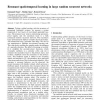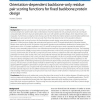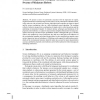188 search results - page 31 / 38 » Improving protein secondary structure prediction using a sim... |
BC
2002
13 years 7 months ago
2002
Taking a global analogy with the structure of perceptual biological systems, we present a system composed of two layers of real-valued sigmoidal neurons. The primary layer receives...
BMCBI
2010
2010
Orientation-dependent backbone-only residue pair scoring functions for fixed backbone protein design
13 years 7 months ago
Background: Empirical scoring functions have proven useful in protein structure modeling. Most such scoring functions depend on protein side chain conformations. However, backbone...
BMCBI
2008
13 years 7 months ago
2008
Background: Empirical binding models have previously been investigated for the energetics of protein complexation (G models) and for the influence of mutations on complexation (i....
BMCBI
2007
13 years 7 months ago
2007
Background: Metalloproteins are proteins capable of binding one or more metal ions, which may be required for their biological function, for regulation of their activities or for ...
ISER
2004
Springer
14 years 26 days ago
2004
Springer
We present a series of experiments concerned with the inspection of regular, engineered structures carried out using swarms of five to twenty autonomous, miniature robots, solely ...



